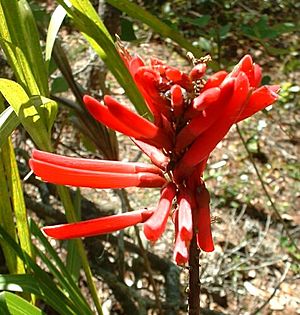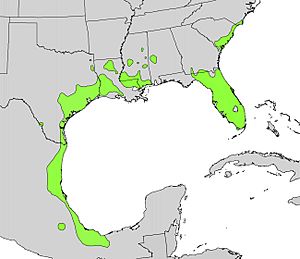Coral bean facts for kids
Quick facts for kids Coral bean |
|
|---|---|
 |
|
| Flowers | |
| Conservation status | |
| Scientific classification | |
| Kingdom: | |
| (unranked): | |
| (unranked): | |
| (unranked): | |
| Order: | |
| Family: | |
| Genus: |
Erythrina
|
| Species: |
E. herbacea
|
| Binomial name | |
| Erythrina herbacea |
|
 |
|
| Natural range | |
| Synonyms | |
|
Erythrina arborea Small |
|
The coral bean (scientific name: Erythrina herbacea) is a beautiful flowering shrub or small tree. It is also known by other names like Cherokee bean, Mamou plant, red cardinal, or cardinal spear. You can find this plant growing naturally in the southeastern United States and northeastern Mexico. It has also been seen in parts of Central America. Sometimes, it grows in new places after being brought there by people, like in Pakistan.
Contents
What Does the Coral Bean Look Like?
The coral bean plant can grow as a low shrub or a small tree. It can reach about 5 meters (16 feet) tall in warm places. In colder areas, it might only grow to about 1.2 meters (4 feet) because freezing weather can make it die back. Its stems have curved spines.
The leaves are a yellowish-green color. They are about 15 to 20 centimeters (6 to 8 inches) long and 6 centimeters (2.4 inches) wide. Each leaf is divided into three smaller, arrowhead-shaped leaflets. These leaflets are about 2.5 to 8 centimeters (1 to 3 inches) long. The bark of the plant is smooth and light gray.
The flowers are a bright red color and look like tubes. They grow in long spikes, with each flower being about 4 to 6.5 centimeters (1.6 to 2.6 inches) long. The coral bean usually blooms from April to July. After the flowers, the plant grows pods that are about 5 to 10 centimeters (2 to 4 inches) long. These pods hold bright red seeds, which give the plant its name.
It is very important to know that this plant, especially its bright red seeds, contains natural chemicals that are poisonous if eaten. It's very important never to eat any part of the coral bean plant.
Where Does the Coral Bean Grow?
The coral bean grows best in sandy soils. It can also handle a moderate amount of salt. You can often find it in open woods, clearings in forests, hammocks (areas of higher ground), and places where the land has been disturbed.
In the United States, it grows from southeastern North Carolina down to Florida. It also grows west to southeastern Oklahoma and eastern Texas. In Mexico, you can find E. herbacea in the state of Tamaulipas.
Interestingly, the coral bean is also found in some parts of the Dragoon Mountains in Southern Arizona. People believe it might have been brought there a long time ago through trade. This could have been by the Mogollon culture, who lived there from 150 AD to 1400 AD. Later, the Apache people also lived in that area.
How People Use the Coral Bean
The coral bean can be grown in gardens, especially in places where it naturally grows. Even though it's not super common in gardens, people who do grow it really like it. They enjoy its bright colors early in the growing season. It's also a tough plant that can survive in many climates (USDA Zones 7-10). Plus, it helps attract hummingbirds to the garden!
Native American people used this plant in many ways for medicine. Different groups of people used it for different things. For example, Creek women used a special liquid made from the root for stomach pain. The Choctaw people used a liquid from the leaves as a general health tonic. The Seminole people used extracts from the roots for digestion problems. They also used extracts from the seeds or the inner bark to rub on the skin for muscle discomfort.
In Mexico, the seeds of the coral bean were used to make rat poison. The bark and leaves were used to make a poison for fish.
In some countries in Central America, the flowers of the coral bean are used in cooking. They are often added to bean soup or meat patties.
See also
 In Spanish: Erythrina herbacea para niños
In Spanish: Erythrina herbacea para niños



